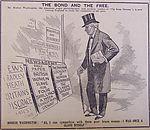 Booker T. Washington cartoon
Booker T. Washington cartoon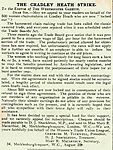 Appeal for donations
Appeal for donations Report of Pathe film
Report of Pathe film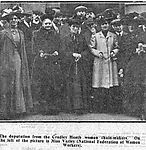 Delegation to T.U.C.
Delegation to T.U.C.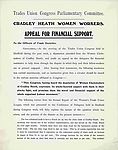 T.U.C. appeal, p1
T.U.C. appeal, p1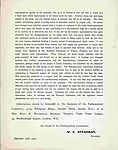 T.U.C. appeal, p2
T.U.C. appeal, p2 Progress on the appeal
Progress on the appeal Contributions from factories
Contributions from factories The Women's prayer
The Women's prayer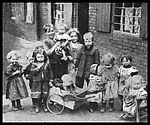 Workers' children
Workers' children

When the strike began, no-one could be sure that there would be sufficient funds to sustain it. Those chainmakers, who belonged to the National Federation of Women Workers, could call on the Union’s strike fund, but over half of the women did not belong to a union. They had to depend on the good-will and generosity of the public at large. Without it they would have been faced with a choice between starvation, or a return to work for starvation wages. It was Mary Macarthur who waged a national publicity campaign, which exposed the chainmasters as perpetuators of sweated labour, and which brought donations flooding in.
Mary arranged interviews with the women, wrote letters to trade unions and leading newspapers throughout the country. She addressed meetings, and even used the power of the cinema to illustrate the plight of the domestic chainmaker. In September Messrs. Pathe released cinematograph films giving a vivid representation of the women in the act of chainmaking, clearly showing the arduous nature of the work. A scene in which little children are playing around the forge is followed by some incidents of the strike, including a procession of the women, accompanied by a large crowd of sympathisers. It had explanatory headlines giving the wages received by the women for their work. The films were shown at the principal music-halls in London, and between 500 and 600 picture theatres in all parts of the country. The manager of Messrs. Pathe estimated that during a two week period the film would have been seen by 10 million people.
As well as attracting the whole of the West Midland’s Conservative press to the side of the women, Mary stimulated the interests of major national newspapers. “The Times”, whilst quick to point out that it did not often approve of strikes, made an exception in the case of the women chainmakers of Cradley Heath, for their “ill clad, destitute appearance evoked universal sympathy.” (1st Sept. 1910)
Reynold’s News immortalized the women as, "The White Slaves of England”, whilst another newspaper declared that the conditions of the women were worse than those of the Chinese compounds in South Africa, the discovery of which had contributed to Britain’s involvement in the Boer War.
On the 4th September 1910 a cartoon appeared in Reynold’s Newspaper depicting the freed slave and founder of the first university for black students, the American, Booker T. Washington. It shows him sympathising with the women, because "I was once a slave myself." Mr. Washington was on a private visit to England to see something of the political, social and economic conditions of life in England in August 1910. He would have been aware of the strike, and no doubt commented upon it, though there is no evidence that he actually visited Cradley Heath in person.
The grievances of the women chainmakers received such notoriety that foreign social investigators flocked to this industrial plague spot. The German researcher, Herr Kummer, described Cradley Heath as “hell”. An Australian, Mr Bricknell, was amazed to find that the chainmakers were living in accommodation which, in his own country, people would not house their cattle in. The International Association for Labour Legislation sent two American investigators to Cradley Heath to examine the conditions under which the women worked. When Will Anderson, Chairman of the Independent Labour Party, attended an international conference in Copenhagen, he found the women chainmakers the centre of conversation.
The women chainmakers had the substantial support of the Anti-Sweating League, the Women’s Trade Union League and of course the National Federation of Women Workers. The Trade Union Congress (T.U.C.) saw to it that every trade union was made aware of their struggle. A deputation of the women chainmakers had attended the annual Trade Union Congress at Sheffield in September. The Daily News wrote “on the flower-decked platform appear three worn and pale-faced women clad in black, and holding forth a chain….one of them spoke…. But though she scarcely uttered 20 words, the remembrance of her terrible misery gave an eloquent ring to her pleading voice. For making this yard of chain, she said, we get a penny.”
The Congress, as a result, pledged the women chainmakers the moral and financial support of the whole organized labour movement. An instruction was given that a circular be issued to the various societies affiliated to the TUC. A copy is included above.
Labour party politicians took every opportunity to raise the issue at their meetings. Arthur Henderson, for example, at a meeting in Sheffield, voiced a desire to see all the pulpits of the country hung with chains made by sweated labour. Short of that, he expressed a wish that all chainmasters might be made to see their own wives put to chainmaking.
The chainmakers also found support amongst the business community. Edward Cadbury criticized the actions of the chainmasters. He said that in the Birmingham area a minimum living income for a woman was 14s a week. He employed three thousand women, and in his business he considered it unjust to employ women under twenty years of age for less than 16s. Yet the women chainmakers were asking for only 11s. Edward Cadbury also pointed out that this was no ordinary strike. The women were merely trying, by taking their stand, to implement an Act of Parliament.
A number of churchmen spoke out in support of the women chainmakers, including the Dean of Worcester. Professor Walter Rauschenbusch, an exponent of Social Christianity, wrote a prayer for all women workers. It is included in the images above. The prayer was said for the women chainmakers in churches around the country.
Even Cradley Heath’s children seemed to enter into the spirit of the time. People stepping off the train were greeted with, “Gimme a nod, missus.” The children collected nods for good luck from visitors to Cradley Heath. They marked a cross on a piece of paper for each nod. When they had a hundred, they buried the paper for two days, then dug it up, soaked it in a bucket of water for a day, and then burnt it at the forge, and while it was burning they made a wish. That wish, they said, was bound to come true. Perhaps they wished for more money in their mothers’ pockets.
Donations flooded in. Mary Macarthur reported that twenty people were working day and night, acknowledging letters that were pouring in from all over the country. By the second week of the strike, grants had been received from over two hundred trade societies in different parts of the country. Collections were made on the women’s behalf outside churches, chapels, factories and Labour Party meetings. Gifts were also made in kind, including a collection of old-fashioned jewellery, lace goods from a lace-maker in Ireland, a van load of bread, and two hams for a tea for the women.
At one of the meetings Julia Varley told the story of the house to house appeal, which took her to the dwelling of a woman, who appeared to be very poor herself. “When I saw her I was almost ashamed to tell her the object of my call. She said eagerly when I mentioned the chainworkers of Cradley Heath, ‘I must do what I can to help those poor women. I will give you what I have, though it is only a ha’penny’.” (Express and Star, 1.9.1910)
Members of the aristocracy and prominent business families also made contributions. For example, the Countess Beauchamp sent a cheque for £100. The Countess of Warwick contributed £25, with the promise of a further £25 in a month if necessary. George Cadbury pledged £5 per week for as long as the strike lasted. Novelist John Galsworthy gave £10, and Mr Arthur Chamberlain donated fifty guineas (£52.50)
Mary Macarthur had hoped that contributions would reach £1000, at which point they would be in a position to accept the terms offered by the Manufacturers’ Association, with regard to guaranteeing that no women would go back to work for less than the new rate. By 12th September the fund exceeded £2,000. By October a sum close to £4,000 had been collected. A successful end to the strike left a substantial surplus in the strike fund. A third of it was divided amongst the National Federation of Women Workers, the Women’s Trade Union League and the Anti-Sweating League. The remaining two thirds, however, were used to benefit the women workers of Cradley Heath, by providing them with a Workers’ Institute. The building, which has been reconstructed on the Museum’s site, is a lasting monument to the courage and determination of the Cradley Heath women chainmakers, and all those who supported them.
Rollover the captions in the box to see the available images in thumbnail format, click the caption to see the full-size image
| Reference: | 729 |
| Keywords: | |
| Archive Ref: | |
| Updated: | Tue 17 Jul 2007 - 1 |
| Interpretation written by | Barbara Harris |
| Author's organisation | |
| Organisation's website |